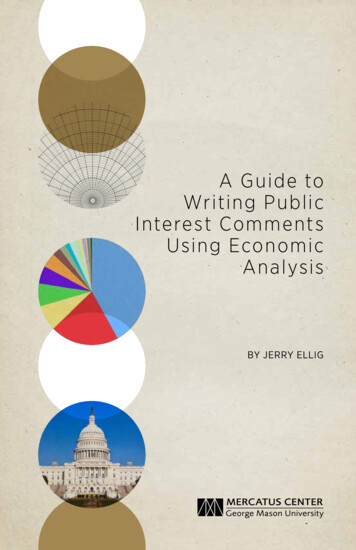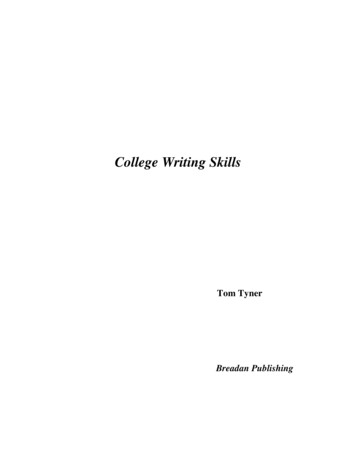
Transcription
A Guide toWriting PublicIntere s t Comment sUsing EconomicAnalysisBY JERRY ELLIG
“Wise regulatory decisions depend on publicparticipation and on careful analysis of the likelyconsequences of regulation. Such decisions are informedand improved by allowing interestedmembers of the public to have a meaningfulopportunity to participate in rulemaking.”—President Barack Obama, Executive Order 13579Copyright 2014 by Jerry Elligand the Mercatus Center at George Mason UniversityMercatus CenterGeorge Mason University3434 Washington Blvd., 4th FloorArlington, VA 22201703-993-4930mercatus.orgReleased October 2014
The federal government’s own tips for submitting effectivecomments in regulatory proceedings note, “A constructive, information-rich comment that clearly communicates and supports its claims is more likely to have an impact onregulatory decision-making.”1 This guide explains how to preparea comment on a proposed regulation, using economic analysis thatsupports each claim. This guide is not intended to promote anyparticular viewpoint, to advance any specific policy, or to promotethe interests of any group. Instead, it is intended to be a resourcefor any person or organization seeking to write comments thatimprove regulators’ knowledge of the economic consequences ofproposed regulations.2Comments on proposed regulations require some substantiveknowledge about law and policy in addition to economics. Butunderstanding how the regulatory process works, the factors thataffect regulatory decisions, and the legal environment regulatorsface should not be difficult for anyone with an analytical bent.Substantive economic research, presented in the right format,has the potential to alter regulatory decisions in ways that willimprove the lives of millions of people. This guide presents six1. “Tips for Submitting Effective Comments,” accessed May 7, 2013, http://www.regulations.gov/docs/Tips For Submitting Effective Comments.pdf.2. For a good general guide to writing comments on regulations that covers aspectsother than economic analysis, see Elizabeth Mullin, The Art of Commenting(Washington, DC: Environmental Law Institute, 2000).1
A G U I D E TO W R I T I N G P U B L I C I N T E R E S T C O M M E N T Sfundamental actions that will give your comment the maximumadvantage:1.Understand the regulatory process.2. Appreciate the regulatory agency’s definition of “the public interest.”3.Know the key topics that a good economic regulatoryanalysis should address.4. Recognize the agency’s legal authority and constraints.5.Write your comment in the appropriate format, language,and tone.6. Tell other interested parties about your comment.2
1. UNDERSTAND THEREGULATORY PROCESSFederal regulations exist because Congress delegates lawmaking authority to federal agencies. Agencies exercisethis authority by writing regulations. They are requiredto follow certain procedures as they do so, which often includeperforming economic analysis of the proposed rules.3 By helpingagencies get the economic analysis right, a public interest comment can promote better regulatory decisions.A BRIEF SYNOPSIS OF THE REGULATORY PROCESSThe origin of every legal regulation is a law passed by Congress.Each spring and fall, the federal government publishes its UnifiedAgenda of Federal Regulatory and Deregulatory Actions, which issupposed to list all the regulations that agencies are either considering or working on.4 If you want to start researching a topicbefore an agency issues a regulation, this document provides someidea of what regulations are under development. Be aware, however, that regulations can remain listed in the Unified Agenda foryears before they are proposed, and sometimes regulations are3. For a more extensive explanation of the regulatory process, see Jerry Brito andSusan Dudley, Regulation: A Primer, 2nd ed. (Arlington, VA: Mercatus Center atGeorge Mason University, 2012), 4. For further explanation of this document, see Regulatory Information ServiceCenter, “Introduction to the Unified Agenda of Federal Regulatory and DeregulatoryActions,” May 23, 2014, wer?objectId 0900006481710e86&disposition attachment&contentType pdf.3
A G U I D E TO W R I T I N G P U B L I C I N T E R E S T C O M M E N T Sproposed that were never listed in this document.The Administrative Procedure Act (APA) normally requiresregulatory agencies to publish proposed regulations in the FederalRegister for public comment. The APA requires that agency decisions not be “arbitrary, capricious, an abuse of discretion, or otherwise not in accordance with law.”5 In part, this requirementmeans that the agency must support every decision with plausible reasoning based on the public record. Agencies must considercomments from the public before they issue a final regulation. Thefinal regulation is accompanied by a preamble that explains theagency’s responses to arguments raised by commenters, but theagency does not have to respond to each individual comment.In some cases, an agency may issue an “interim final” regulationthat takes effect immediately. Usually, the agency will still solicitcomments on an interim final regulation and may revise it later.Many regulatory agencies, such as the Department ofTransportation and the Department of Health and HumanServices, are considered part of the executive branch. For executive branch agencies, the Office of Information and RegulatoryAffairs (OIRA) within the Office of Management and Budget(OMB) reviews proposed and final regulations, along with theaccompanying economic analysis, before the agency can publishthe proposed or final regulation in the Federal Register. OIRAcan return regulations to agencies for reconsideration, effectively blocking the regulation. However, OIRA does not reviewregulations from “independent” regulatory agencies unless theagency requests it. An independent regulatory agency is an agencywhose head cannot be removed by the president except for cause.Examples include the Federal Communications Commission, theFederal Reserve Board, and the Nuclear Regulatory Commission.Final regulations may still face two additional hurdles. First,Congress has an opportunity to review final regulations before5. 5 U.S.C. § 706 (2010), available at Cornell University Law School LegalInformation Institute, http://www.law.cornell.edu/uscode/text/5/706.4
JE R R Y E L L I Gthey take effect. Under the Congressional Review Act, Congresscan utilize an expedited legislative process to veto final regulations.6 Because a congressional resolution disapproving a regulation is a law, it cannot take effect unless the president (whoseadministration wrote the regulation) also signs it or unlessCongress overrides the presidential veto. For this reason, onlyone regulation has ever been overturned using the CongressionalReview Act.Second, a regulation might undergo judicial review. The regulation may be challenged in court on a variety of grounds. A litigant may claim that the agency overstepped its authority underthe law, ignored a factor the law says it had to take into account,or acted arbitrarily or capriciously by failing to provide a reasonedexplanation for a decision it made.THE ROLE OF ECONOMICS IN THE REGULATORY PROCESSRegulations with large effects are often accompanied by economicanalysis. There are several types of legal requirements for economic analysis:7 Executive Order (EO) 12866 requires executive branchagencies to explain the purpose and assess the benefitsand costs of “significant” regulations.8 A significant regulation is one that has material and adverse effectson the economy, environment, public health, or otherlevels of government; creates an inconsistency with6. 5 U.S.C. § 804 (2012).7. For a comprehensive summary of analytical mandates that apply to federal regulatory agencies, see Curtis W. Copeland, Regulatory Analysis Requirements: AReview and Recommendations for Reform, report prepared for the AdministrativeConference of the United States (April 23, 2012), Final-Reg-Analysis-Report-for-5-3-12-Mtg.pdf.8. Exec. Order No. 12866, 58 Fed. Reg. 190 (October 4, 1993), 51735, § 6(a)(3)(B). Agencies initially designate which regulations are significant, and the OIRAadministrator can designate additional regulations as significant after reviewingthe agencies’ regulatory plans. Id. § 6(a)(3)(A).5
A G U I D E TO W R I T I N G P U B L I C I N T E R E S T C O M M E N T Sanother agency’s actions; materially alters federalexpenditures or revenues; or raises novel legal or policyissues.9 “Economically significant” regulations—generally, regulations with costs, benefits, or other economiceffects exceeding 100 million annually—have moreextensive requirements for analysis and quantificationof results.10 Economically significant regulations must beaccompanied by an analysis that evaluates the nature andsignificance of the problem that the agency seeks to solve,identifies alternative solutions, and assesses the benefitsand costs of those alternatives.11 The economic analysisaccompanying significant and economically significantregulations is commonly referred to as a regulatoryimpact analysis (RIA).12 The Unfunded Mandates Reform Act requires executive branch agencies to assess the benefits and costs ofmandated expenditures on state, local, and tribal governments and on the private sector.13 In practice, the economic analyses that agencies produce under ExecutiveOrder 12866 usually also satisfy the requirements of theUnfunded Mandates Reform Act.149. Id. § 3(f).10. Id. § 3(f)(1). The term “economically significant” appears nowhere in the executive order, but it has become a term of art in the regulatory community that refersto regulations that are significant under the definition in § 3(f)(1): “Have an annualeffect on the economy of 100 million or more or adversely affect in a material waythe economy, a sector of the economy, productivity, competition, jobs, the environment, public health or safety, or State, local, or tribal governments or communities.”11. Id. § 6(a)(3)(B) and § 6(a)(3)(C).12. This term appears nowhere in EO 12866, but it was used in the predecessor, EO12291, to refer to the economic analysis agencies must submit to OIRA. See Exec.Order No. 12291, 46 Fed. Reg. 13193 (Feb. 19, 1981), § 3(a).13. 2 U.S.C. §§ 1532–38.14. “Because of numerous exceptions and exclusions in the Act, the set of rules thatare subject to [the Unfunded Mandates Reform Act’s] analytical requirements area subset of the rules that are subject to the analytical requirements in EO 12866.”Curtis W. Copeland, Economic Analysis and Independent Regulatory Agencies,6
JE R R Y E L L I G The Regulatory Flexibility Act requires independent aswell as executive branch regulatory agencies to determine whether a regulation would have a significantimpact on a substantial number of small businesses, governments, or nonprofit institutions.15 If so, the agencymust consider alternatives that would minimize theimpact on these small entities. An agency’s RegulatoryFlexibility Act analysis will have information about theincidence of regulatory costs (particularly how theyaffect entities of different sizes) and alternatives that theagency considered. The Small Business Administration’sOffice of Advocacy monitors agency compliance withthe Regulatory Flexibility Act and assists agencies withthe required analysis. The Small Business RegulatoryEnforcement Fairness Act allows affected parties to seekjudicial review of the agency’s Regulatory Flexibility Actanalysis and its decisions on whether to grant regulatoryrelief to small businesses.16 Any information or analysis you offer on these topics becomes part of the publicrecord that the courts would review. The Paperwork Reduction Act requires both independent and executive branch regulatory agencies to estimate the size of the paperwork burden associated withany requests for information from the public, includingpaperwork burdens created by regulations.17 OIRA mustapprove information requests that involve more than nineindividuals or entities. An agency’s Paperwork ReductionAct analysis provides information about this one particular type of regulatory cost.report prepared for the Administrative Conference of the United States (April 30,2013), 20.15. 5 U.S.C. §§ 601–12.16. 5 U.S.C. § 611.17. 44 U.S.C. §§ 3501–20.7
A G U I D E TO W R I T I N G P U B L I C I N T E R E S T C O M M E N T S Some agencies have specific requirements to performeconomic analysis in their authorizing legislation or in legislation authorizing a particular regulation. The FederalTrade Commission (FTC), for example, must explain theneed for and objectives of a rule, describe the alternatives the commission considered, explain why it chosethe alternative it did, and assess the benefits and costs ofthe rule.18 The Securities and Exchange Commission isrequired to consider the effects of proposed rules on competition, efficiency, and capital formation, which courtshave interpreted as a requirement to conduct benefit-costanalysis.19 Table 1 shows the most extensive published listof economic analysis requirements for independent agencies. Not all rules issued by these agencies are subject tothese statutory requirements.20 Some agencies are required to consider specific economicfactors when they issue regulations. They thus have toconduct an analysis relevant to the required topics evenwhen the legislation does not require a full RIA. Forexample, when promulgating energy efficiency regulations, the Department of Energy must set standards thatachieve the maximum energy savings that are “technologically feasible and economically justified.”21 As a result,the department must consider the costs of alternativeenergy efficiency standards.18. 15 U.S.C. § 57b-3(b)(2).19. Business Roundtable v. SEC, 647 F.3d 1144 (D.C. Cir. 2011). For an extensive explanation and assessment of the quality of the SEC’s regulatory analysis,see Jerry Ellig and Hester Peirce, “SEC Regulatory Analysis: A Long Way to Goand a Short Time to Get There,” Brooklyn Journal of Corporate, Financial, andCommercial Law 8 (2014): 361–437.20. For a more extensive description of these requirements, see Curtis W.Copeland, Economic Analysis and Independent Regulatory Agencies, and HesterPeirce, “Economic Analysis by Federal Financial Regulators” (Working Paper No.12-31, Mercatus Center at George Mason University, Arlington, VA, October lysis-federal-financial-regulators.21. Copeland, Regulatory Analysis Requirements, 43.8
JE R R Y E L L I GTABLE 1. STATUTORY ECONOMIC ANALYSIS REQUIREMENTS FORCERTAIN INDEPENDENT AGENCIESAgencyStatutory analytical requirementsCost-benefit analysis requirementsConsumer ProductSafety Commission(consumer productsafety and other rules)Prepare regulatory analysis describing potentialbenefits and costs of rule, benefits and costs ofalternatives considered, and why alternatives notselected. 15 U.S.C. § 2058(f)(2).Federal Reserve(electronic fund t ransfers)Prepare an analysis of economic impact thatconsiders the costs and benefits to financialinstitutions, consumers, and other users of electronic fund transfers. 15 U.S.C. § 1693b.Federal TradeCommissionInclude statement of need and objectives, analysisof projected benefits and any adverse effects, andan explanation of why the particular alternativewas chosen. 15 U.S.C. § 57b-3(b)(2).“Consider” requirementsSecurities andExchange CommissionConsider, in addition to the protection of investors, whether the action will promote efficiency,competition, and capital formation. E.g., 15U.S.C. § 77b(b). Also, consider the impact of therule on competition. 15 U.S.C. § 78w(a)(2).Commodity FuturesTrading CommissionConsider the costs and benefits of the action ofthe Commission before promulgating a regulation. 7 U.S.C. § 19(a).Banking agencies(Riegle Act)Consider any administrative burdens that a rulewould place on depository institutions, as well asthe benefits of the rule. 12 U.S.C. § 4802(a).Consumer FinancialProtection Bureau(Dodd-Frank Act)Consider the potential benefits and costs ofupcoming rules on consumers and others. 12U.S.C. § 5512.Source: Curtis W. Copeland, Economic Analysis and Independent Regulatory Agencies, report prepared for theAdministrative Conference of the United States (April 30, 2013), 56.9
A G U I D E TO W R I T I N G P U B L I C I N T E R E S T C O M M E N T SSome agencies employ economic analysis simply due to the natureof the regulations they issue. The Federal CommunicationsCommission and Federal Energy Regulatory Commission, forexample, are economic regulatory agencies. They regulate prices,entry into markets, terms of transactions between businesses,disclosure of contract terms to consumers, and similar concerns.Because their regulations are fundamentally economic in nature,they are likely to be accompanied by some economic analysis sothat the agency can demonstrate its decisions are not arbitrary orcapricious. However, the analysis required to demonstrate that adecision is not arbitrary or capricious falls far short of a full RIA.An agency’s economic analysis may be sprinkled throughoutthe notice of proposed rulemaking (NPRM) as part of the agency’sjustification for the regulation, or it may be in a separate RIA section or document.22The comment process for a regulation is supposed to be basedon reasoning, discussion, and evidence; it is not a democratic vote.Interest groups sometimes gin up postcard or email campaigns toencourage multiple individuals to submit numerous short, boilerplate comments; these rarely carry much weight. A commenter’sskill as an analyst is what counts. Effective comments provide useful information about the likely effects of the proposed regulationand the alternatives.23 Surveys of agencies receiving commentsfind that the most useful and effective comments are those thatfurnish data, analysis, or expertise that the agency did not alreadyhave.24 Similarly, a 2011 report prepared for the Administrative22. More rarely, the economic analysis may appear in a separate document called aTechnical Support Document or a Benefit-Cost Analysis.23. “Tips for Submitting Effective Comments,” accessed September 26, 2014,http://www.regulations.gov/docs/Tips For Submitting Effective Comments.pdf; Mullin, Art of Commenting.24. The Federal Trade Commission has a long history of submitting commentsin other government entities’ regulatory proceedings. Twice it has surveyedthe recipients to gauge the effectiveness of its comments. See Organisationfor Economic Co-operation and Development, Directorate for Financial andEnterprise Affairs, Competition Committee, “Roundtable on the Evaluation10
JE R R Y E L L I GConference of the United States noted, “There is little doubt thatcomments at times exert fundamental influence over agencydecision-making. For the most part, however, significant effectsare limited to comments that exhibit high levels of sophistication.Furthermore, there are many instances in which even sophisticated comments are associated with nothing more than marginalchanges in agency proposals.”25You can comment on a proposed regulation, its RIA, or both.The best comments highlight opportunities for improvementin the regulation itself and are supported by economic analysis.In a working paper published by the Mercatus Center at GeorgeMason University, regulatory scholar Stuart Shapiro finds thatcomments based on economic arguments are more than twice aslikely to elicit agreement from agencies than comments relatedto a rule’s legality. When agencies agree with comments, they arevery likely to make changes to regulations based on the information provided in the comments.26A careful critique of the RIA, combined with knowledge ofrelevant economic literature, may reveal that the regulation iseither completely unnecessary or less effective or more costlythan alternatives that the agency considered or could have considered. Alternatively, your analysis may find that the agency correctly diagnosed the problem and picked the most sensible solution available. In that case, the comment (along with citations toof the Actions and Resources of Competition Authorities: Note of the UnitedStates” (May 25, 2007); Arnold C. Celnicker, “The Federal Trade Commission’sCompetition and Consumer Advocacy Program,” St. Louis University Law Journal33 (1988–89): 379–405.25. Steven J. Balla, “Public Commenting on Federal Agency Regulations: Researchon Current Practices and Recommendations to the Administrative Conference ofthe United States” (March 15, 2011), 35, Consolidated-Reports- -Memoranda.pdf.26. Stuart Shapiro, “When Will They Listen? Public Comment and Highly SalientRegulations” (Working Paper No. 13-15, Mercatus Center at George MasonUniversity, Arlington, VA, September 2013), 15, 11
A G U I D E TO W R I T I N G P U B L I C I N T E R E S T C O M M E N T Srelevant research) can help support the agency’s decision in theface of hostile criticism that it may receive from other parties.The ultimate goal of a public interest comment is to affect decisions. The key to a successful comment is not just to point out failures to understand economic theories, but to convince an agency(or sometimes OMB or Congress) that a proposed regulationshould be adopted, changed, or dropped.12
2. APPRECIATE THEREGULATORY AGENCY’SDEFINITION OF “THE PUBLICINTEREST”Any member of the public, whether an individual or agroup, can comment on a regulation. What makes a public interest comment different from other types of comments is that it is written from the perspective of the general welfare, rather than representing the interest of a particular group oraffected entity.There are many different definitions of “the public interest,”and each definition presupposes certain value judgments andsome concept of what constitutes a “good” society. Keep in mindthat the economic analysis is not the same thing as the regulatory decision. Analysis is about understanding reality—what is andwhat is not likely to happen as a result of a regulation. Of courseany regulatory analysis will be based on simplifications of reality (models), which abstract away from less important details inorder to identify the key causes of the regulation’s major effects.The purpose of the analysis is not to automate the decision, butrather to identify the likely consequences of both the regulation and its alternatives. Moving from the analysis to a decisionrequires a value judgment, an “ought.”Many economists supply the “ought” by assuming that thepublic interest equates to economic efficiency or consumer welfare. This understanding presumes a particular utilitarian ethicaltheory. When you support your comment with economic analysis, you should be aware that other commenters, as well as thedecision makers who review public comments, may not shareyour concern for economic efficiency and may hold other ethical13
A G U I D E TO W R I T I N G P U B L I C I N T E R E S T C O M M E N T Stheories. These theories might include the Rawlsian notion thatinequalities can only be justified if they maximize the welfare ofthose who are least well off; the Marxian concept of “from eachaccording to his ability, to each according to his needs”; or a vaguenotion that the agency serves the public interest when it accomplishes the maximum possible amount of some goal that can befound in (or read into) the authorizing legislation. These theorieswill often be implicit, rather than explicitly stated in the NPRM.Your analysis should be useful to everyone, not just to advocates of economic efficiency. It should provide an organizedframework for assessing the likely consequences of a regulationand its alternatives. As you critique the agency’s analysis and offeradditional literature, data, or insights, try to present your views ina way that is useful to decision makers even if they are not usingeconomic efficiency as their sole criterion.To make your comments as relevant as possible, you shouldunderstand how the agency you are addressing defines the public interest. If the agency appears to share your view of the public interest, you can present your analysis as advice on how theagency can better accomplish the goals you share. You may alsowant to buttress the agency’s definition of the public interest incase other commenters urge the agency to define the public interest differently.You need to know when your view of the public interest conflicts with the agency’s view because, in some cases, you will haveno alternative other than to argue as diplomatically as possiblethat the agency ought to take your concept of the public interestinto account. If the agency has a different underlying theory ofthe public interest, you may still be able to explain why the agencyneeds to understand your points if it wants to accomplish its goals.In some cases, the comment process will involve explicit arguments about the definition of “the public interest” because itappears in the statute as a criterion the agency must employ whenmaking decisions. In other cases, the term may not appear in thestatute, but various parties’ concepts of the public interest will14
JE R R Y E L L I Gaffect how they choose to interpret other statutory criteria theagency is supposed to use to make decisions. Four factors influence regulatory decisions by shaping an agency’s concept of thepublic interest:1.Enabling law(s). The agency must base its regulation onan underlying statute. The statute may be the “organic”statute that created the agency and defined its mission, orit may be a statute requiring or empowering the agency toissue a specific regulation. Often an agency will also citeother evidence of congressional intent, such as committeereports or legislative debate, that it believes support itsinterpretation of congressional intent.Some statutes include a requirement that the agencyperform economic analysis or consider economic factorswhen making decisions. Check to see if the statute authorizing the regulation you are commenting on includes anyeconomic analysis requirements; if so, you will have additional leverage to persuade the agency to pay attention toyour analysis.2.Past court decisions. The agency will strive to write theregulation in a way that is consistent with past court decisions in order to help ensure that courts will uphold theregulation if it is challenged.3.Explicit presidential direction. This is derived primarily from executive orders but also from speeches and memoranda. Executive Order 12866 requires muchmore evidence than the APA does to show that decisions are rational. That is, the APA can be satisfied withan anecdote; the executive order’s requirement that aregulation’s benefits justify its costs requires much more rigorous analysis.Courts do not review compliance with executive orders.But since OIRA can return regulations, it has leverage to15
A G U I D E TO W R I T I N G P U B L I C I N T E R E S T C O M M E N T Sencourage agencies to improve their economic analysis andconsider the results of the analysis more seriously whenmaking decisions. For example, a 2012 regulation mandating hours of service for airline flight crews was rewrittenduring the review period to exempt cargo-only airlines. Therevised benefit-cost analysis revealed that the incrementalbenefits of covering cargo airlines were very small compared to the incremental costs.27 More generally, a MercatusCenter working paper found that longer OIRA review timesare associated with higher-quality RIAs and better explanations of how RIAs informed agency decisions.284. Policy preferences of the administration and its appointees.Presidents normally try to appoint regulators who willcarry out their policies, to the extent that the law allowsthe agency to make discretionary decisions. In executivebranch agencies, political appointees can be removed ifthey make significant regulatory decisions with whichthe president disagrees. Presidents have less control overtheir appointees at independent agencies, but they stilltry to appoint decision makers who share their views.Regulators have discretion to consider benefits, costs, orother economic factors when making regulatory decisions unless a statute prohibits them from doing so.27. See US Department of Transportation, Federal Aviation Administration,“Federal Aviation Administration Compliance with E.O. 12866—Flight Crew Dutyand Rest Requirements,” RIN 2120-AJ58, marked-up draft of Federal Registernotice showing changes in the final rule introduced during OMB review, availablein the docket for this regulation at www.regulations.gov.28. Jerry Ellig and Rosemarie Fike, “Regulatory Process, Regulatory Reform, andthe Quality of Regulatory Impact Analysis” (Working Paper No. 13-13, MercatusCenter at George Mason University, Arlington, VA, July 2013), nalysis.16
3. KNOW THE KEY TOPICSTHAT A GOOD ECONOMICREGULATORY ANALYSISSHOULD ADDRESSFor several decades, executive orders and OMB guidancedocuments have outlined the principal factors that a thorough economic analysis of a proposed regulation shouldinclude.29 Consider the following topics as you review the agency’sanalysis and what points you want to make.30 You will not necessarily address all these issues in your comment; in fact, to do sowould be quite unusual. But this list will help you assess whetherthe agency has done its homework and identify any missing piecesof its analysis.SYSTEMIC PROBLEMThe first and most fundamental question to consider when analyzing a regulation
record that the courts would review. The Paperwork Reduction Act requires both indepen - dent and executive branch regulatory agencies to esti - mate the size of the paperwork burden associated with any requests for information from the public, including paperwork burdens created by regulations. 17 OIRA must











